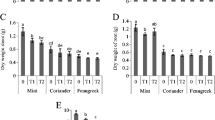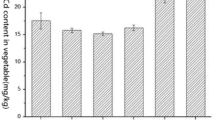Abstract
Vegetables and crops can take up heavy metals when grown on polluted lands. The concentrations and dynamic uptake of heavy metals vary at different growth points for different vegetables. In order to assess the safe consumption of vegetables in weak alkaline farmlands, Chinese cabbage and radish were planted on the farmlands of Baiyin (polluted site) and Liujiaxia (relatively unpolluted site). Firstly, the growth processes of two vegetables were recorded. The growth curves of the two vegetables observed a slow growth at the beginning, an exponential growth period, and a plateau towards the end. Maximum concentrations of copper (Cu), zinc (Zn), lead (Pb), and cadmium (Cd) were presented at the slow growth period and showed a downtrend except the radish shoot. The concentrations of heavy metals (Cu, Zn, and Cd) in vegetables of Baiyin were higher than those of Liujiaxia. In the meanwhile, the uptake contents continued to increase during the growth or halted at maximum at a certain stage. The maximum uptake rates were found on the maturity except for the shoot of radish which took place at the exponential growth stages of root. The sigmoid model could simulate the dynamic processes of growth and heavy metals uptake of Chinese cabbage and radish. Conclusively, heavy metals have higher bioaccumulation tendency for roots in Chinese cabbage and for shoots in radish.



Similar content being viewed by others
References
Avci H, Deveci T (2013) Assessment of trace element concentrations in soil and plants from cropland irrigated with wastewater. Ecotoxicol Environ Saf 98:283–291
Garg VK, Yadav P, Mor S, Singh B, Pulhani V (2014) Heavy metals bioconcentration from soil to vegetables and assessment of health risk caused by their ingestion. Biol Trace Elem Res 157:256–265
Harrison RM, Chirgawi MB (1989) The assessment of air and soil as contributors of some trace metals to vegetable plants III. Experiments with field-grown plants. Sci Total Environ 83:47–62
Jolly YN, Islam A, Akbar S (2013) Transfer of metals from soil to vegetables and possible health risk assessment. Springerplus 2:385
Khan MU, Malik RN, Muhammad S (2013) Human health risk from heavy metal via food crops consumption with wastewater irrigation practices in Pakistan. Chemosphere 93:2230–2238
Kirkham MB (2006) Cadmium in plants on polluted soils: effects of soil factors, hyperaccumulation, and amendments. Geoderma 137:19–32
Kumar Sharma R, Agrawal M, Marshall F (2007) Heavy metal contamination of soil and vegetables in suburban areas of Varanasi, India. Ecotoxicol Environ Saf 66:258–266
Lai HY, Chen BC (2013) The dynamic growth exhibition and accumulation of cadmium of pak choi (Brassica campestris L. ssp. chinensis) grown in contaminated soils. Int J Environ Res Public Health 10:5284–5298
Li F, Ni L, Yuan J, Daniel Sheng G (2010) Cultivation practices affect heavy metal migration between soil and Vicia faba (broad bean). Chemosphere 80:1393–1398
Li F-l, Yuan J, Sheng GD (2012) Altered transfer of heavy metals from soil to Chinese cabbage with film mulching. Ecotoxicol Environ Saf 77:1–6
Li Y, Wang Y-b, Gou X, Su Y-b, Wang G (2006) Risk assessment of heavy metals in soils and vegetables around non-ferrous metals mining and smelting sites, Baiyin, China. J Environ Sci 18:1124–1134
Liu L, Zhang Q, Hu L, Tang J, Xu L, Yang X, Yong JWH, Chen X (2012) Legumes can increase cadmium contamination in neighboring crops. PLoS One 7:e42944
Liu W, Zhou Q, Sun Y, Liu R (2009) Identification of Chinese cabbage genotypes with low cadmium accumulation for food safety. Environ Pollut 157:1961–1967
Malan M, Muller F, Cyster L, Raitt L, Aalbers J (2015) Heavy metals in the irrigation water, soils and vegetables in the Philippi horticultural area in the Western Cape Province of South Africa. Environ Monit Assess 187:4085
Molina M, Escudey M, Chang AC, Chen W, Arancibia-Miranda N (2013) Trace element uptake dynamics for maize (Zea mays L.) grown under field conditions. Plant Soil 370:471–483
Moreno DA, Villora G, Hernandez J, Castilla N, Romero L (2002) Accumulation of Zn, Cd, Cu, and Pb in Chinese cabbage as influenced by climatic conditions under protected cultivation. J Agric Food Chem 50:1964–1969
Najafi S, Jalali M (2016) Effect of heavy metals on pH buffering capacity and solubility of Ca, Mg, K, and P in non-spiked and heavy metal-spiked soils. Environ Monit Assess 188
Pandey J, Pandey R, Shubhashish K (2009) Air-borne heavy metal contamination to dietary vegetables: a case study from India. Bull Environ Contam Toxicol 83:931–936
Rahman MM, Azirun SM, Boyce AN (2013) Enhanced accumulation of copper and lead in amaranth (Amaranthus paniculatus), Indian mustard (Brassica juncea) and sunflower (Helianthus annuus). PLoS One 8:e62941
Sheppard SC, Evenden WG (1992) Concentration enrichment of sparingly soluble contaminants (U, Th and Pb) by erosion and by soil adhesion to plants and skin. Environ Geochem Health 14:121–131
Si W, Ji W, Yang F, Lv Y, Wang Y, Zhang Y (2011) The function of constructed wetland in reducing the risk of heavy metals on human health. Environ Monit Assess 181:531–537
Tsadilas CD, Karaivazoglou NA, Tsotsolis NC, Stamatiadis S, Samaras V (2005) Cadmium uptake by tobacco as affected by liming, N form, and year of cultivation. Environ Pollut 134:239–246
Wang G, MY S, Chen YH, Lin FF, Luo D, Gao SF (2006) Transfer characteristics of cadmium and lead from soil to the edible parts of six vegetable species in southeastern China. Environ Pollut 144:127–135
White PJ, Brown PH (2010) Plant nutrition for sustainable development and global health. Ann Bot 105:1073–1080
Zhou D-M, Hao X-Z, Wang Y-J, Dong Y-H, Cang L (2005) Copper and Zn uptake by radish and pak choi as affected by application of livestock and poultry manures. Chemosphere 59:167–175
Acknowledgments
This work was financially supported by the National Natural Science Foundation of China (Grant No. 41171391) and the Science and Technology Support Program of Gansu Province (No. 1504NKCA082).
Author information
Authors and Affiliations
Corresponding author
Additional information
Editorial Responsible: Yi-ping Chen
Rights and permissions
About this article
Cite this article
Ai, S., Guo, R., Liu, B. et al. A field study on the dynamic uptake and transfer of heavy metals in Chinese cabbage and radish in weak alkaline soils. Environ Sci Pollut Res 23, 20719–20727 (2016). https://doi.org/10.1007/s11356-016-7277-x
Received:
Accepted:
Published:
Issue Date:
DOI: https://doi.org/10.1007/s11356-016-7277-x




